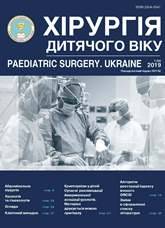The importance of adrenergic blockers to treat children with neuromuscular dysfunction of the bladder
DOI:
https://doi.org/10.15574/PS.2019.64.17Keywords:
children, treatment, bladder, neuromuscular dysfunction of the bladder, α-blockersAbstract
Selective alpha-blockers are widely used in urological practice for the treatment of benign prostatic hyperplasia and lower urinary tract symptoms. Safety and efficacy of selective α-blockers in children with neuromuscular dysfunction of bladder noted a number of foreign authors. However, experience with α-blockers for the treatment of dysfunctions of the urinary bladder in children in Ukraine poor.The aim of the study. To study the safety and efficacy of selective α1-blocker in the treatment of neuromuscular dysfunction of the bladder in children of all ages.
Materials and methods. The safety and efficacy of selective α-blocker doxazosin at a dose of 0.25-1.0 mg/day in the treatment of neuromuscular dysfunction of the bladder in 90 children who were treated in a surgical department No.2 Zhytomyr Oblast Children’s Clinical Hospital were learnt. The age of patients ranged from 1 month to 17 years (mean 4.8 years). The boys were 74 (82.2%), 16 girls (17.8%).
Results. The duration of the drug ranged from 6 months to 3 years. Equipment inspection subject 40 (44.4%) children. In 36 (90%) patients with neuromuscular dysfunction of the bladder were recorded changes in subjective feelings. The noted speaker in urodynamic and ultrasound parameters, indicating improvement Cumulative-evacuation function of the bladder. On the control cystoscopy detected trabekulyarnosti and reducing the number psevdodyvertykuliv.
Conclusions. Thus, the use of selective α-blockers (doxazosin) is safe and quite effective in treatment of neuromuscular dysfunction of the bladder in children. However, without surgical correction causes neuromuscular dysfunction of the bladder, pharmaceuticals monotherapy is inadequate.
The research was carried out in accordance with the principles of the Helsinki Declaration. The study protocol was approved by the Local Ethics Committee (LEC) of all participating institution. The informed consent of the patient was obtained for conducting the studies.
No conflict of interest was declared by the author.
References
Nikitin SS. (2006). The rationale and effectiveness of the combined use of M-cholitics and alpha-blockers in the treatment of children with hyperactive urinary bladder. Abstract of the dissertation candidate of medical science. 14.00.35 pediatric surgery. Moscow: 23.
Austin PF, Homsy YL, Masel JL, Cain MP, Casale AJ, Rink RC. (1999, Sep). alpha-Adrenergic blockade in children with neuropathic and nonneuropathic voiding dysfunction. J Urol. 162 3 Pt 2): 1064-7. https://doi.org/10.1016/S0022-5347(01)68067-4
Austin PF. (2009). The role of alpha blockers in children with dysfunctional voiding. The Scientific World JOURNAL: TSW Urology 9: 880–883. https://doi.org/10.1100/tsw.2009.98; PMid:19734961 PMCid:PMC5823122.
Cain MP, Wu SD, Austin PF, Herndon CD, Rink RC. (2003, Oct). Alpha blocker therapy for children with dysfunctional voiding and urinary retention. J Urol. 170 4 Pt 2): 1514-5; discussion 1516-7. https://doi.org/10.1097/01.ju.0000085961.27403.4a; PMid:14501648.
ClinicalTrials.gov Identifier: NCT00340704)( https://clinicaltrials.gov/ct2/show/study/NCT00340704
Donohoe JM, Combs AJ, Glassberg KI. (2005, Jan). Primary bladder neck dysfunction in children and adolescents II: results of treatment with alpha-adrenergic antagonists. J Urol. 173(1): 212-6. https://doi.org/10.1097/01.ju.0000135735.49099.8c; PMid:15592078
Gleason DM, Lattimer J. (1962). The pressure-flow study: a method for measuring bladder neck resistance. J Urol. 87: 844–852. https://doi.org/10.1016/S0022-5347(17)65057-2
Homsy Y, Arnold P, Zhang W. (2011, Nov). Phase IIb/III dose ranging study of tamsulosin as treatment for children with neuropathic bladder. J Urol. 186(5): 2033-9. https://doi.org/10.1016/j.juro.2011.07.021; PMid:21944133.
Jequier S, Rousseau O. (1987). Sonographic measurements of the normal bladder wall in children. AJR Am J Roentgenol. 149: 563–6. https://doi.org/10.2214/ajr.149.3.563; PMid:3303881
Kroll P, Gajewska E, Zachwieja J, Sobieska M, Ma.nkowski P. (2016). An Evaluation of the Efficacy of Selective Alpha-Blockers in the Treatment of Children with Neurogenic Bladder Dysfunction –Preliminary Findings. Int J Environ Res Public Health. 13: 321. https://doi.org/10.3390/ijerph13030321; PMid:26999168 PMCid:PMC4808984.
Kuo H-C. (2010). The Application of Alpha-adrenergic Receptor Blocker in Lower Urinary Tract Dysfunction that is beyond Benign Prostatic Hyperplasia. Incont Pelvic Floor Dysfunct. 4(3): 73-78.
Sidi AA, Dykstra DD, Gonzalez R. (1986, Jan). The value of urodynamic testing in the management of neonates with myelodysplasia: a prospective study. J Urol. 135(1): 90-3. PMID: 3941475. https://doi.org/10.1016/S0022-5347(17)45527-3
Tafuro L, Montaldo P, Iervolino LR, Cioce F, Del Gado R. (2009). Ultrasonographic bladder measurements can replace urodynamic study for the diagnosis of non-monosymptomatic nocturnal enuresis. BJU International. 105: 108-111. https://doi.org/10.1111/j.1464-410X.2009.08735.x; PMid:19583728
Yucel S, Akkaya E, Guntekin E, Kukul E, Akman S, Melikoglu M, Baykara M. (2005). Can alpha-blocker therapy be an alternative to biofeedback for dysfunctional voiding and urinary retention? A prospective study. The Journal of Urology. 174 4(2): 1612–1615. https://doi.org/10.1097/01.ju.0000179241.99381.5e; PMid:16148665.
Downloads
Issue
Section
License
The policy of the Journal “PAEDIATRIC SURGERY. UKRAINE” is compatible with the vast majority of funders' of open access and self-archiving policies. The journal provides immediate open access route being convinced that everyone – not only scientists - can benefit from research results, and publishes articles exclusively under open access distribution, with a Creative Commons Attribution-Noncommercial 4.0 international license(СС BY-NC).
Authors transfer the copyright to the Journal “PAEDIATRIC SURGERY.UKRAINE” when the manuscript is accepted for publication. Authors declare that this manuscript has not been published nor is under simultaneous consideration for publication elsewhere. After publication, the articles become freely available on-line to the public.
Readers have the right to use, distribute, and reproduce articles in any medium, provided the articles and the journal are properly cited.
The use of published materials for commercial purposes is strongly prohibited.

